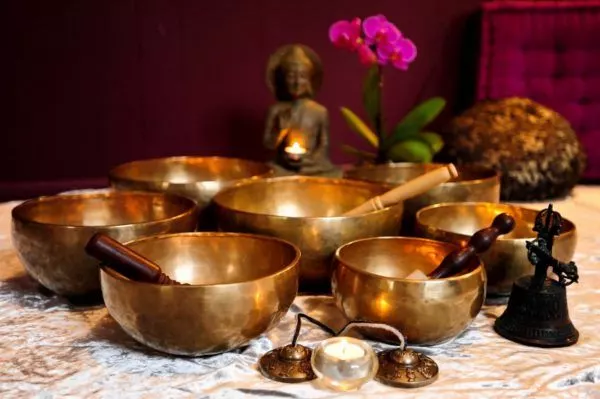Back in August I was camping at a psy-trance festival in the woods of Quebec, where I experienced my first singing bowl concert and healing session. I had often used the sound of these Tibetan singing bowls for pain therapy in the past and had even acquired my own previously, but I had never been completely enveloped in their vibrations.
The concert itself was quite relaxing. The soft tones and melodic chime of the bowls played in succession was emotionally moving. Afterwards, I volunteered for a healing session and was not disappointed. I was asked to lay on the straw mat with a pillow under my head for support while various bowls were placed around me.
The handler then began playing each one in specific order and their vibrations encompassed my body. It lasted a total of 15 minutes and when I was able to sit up again, I felt refreshed and the pain I had been experiencing in my right leg was gone. My mood had considerably lifted as well and I was completely hooked. It was truly a medicinal experience.
History of Tibetan Singing Bowls
 The Tibetan people have used sound therapy for healing and transformation for many centuries. The singing bowl can be traced back to the 5th century, however its exact origin is unknown.
The Tibetan people have used sound therapy for healing and transformation for many centuries. The singing bowl can be traced back to the 5th century, however its exact origin is unknown.
Traditionally, they were used in rituals and even for food storage. They are commonly found in the Himalayan region of Tibet, Nepal, India and China. Many shamans, monks and Buddhists use the bowls in prayer and meditation.
The singing bowl is made of consecrated alloy with a number of metals such as bronze, copper or tin. They are purified while being cast and hammered into shape during the reheating process. They are classified as a type of bell called a standing bell and produce a similar sound when struck.
When played skillfully and “sung” by rubbing the wooden mallet around the edge in a circular motion, the bowl produces a sound that is often referred to as the “sound of the void”. Buddhists will often use the bell as a signal to begin or end a period of silence.
The bowls are made in many different sizes, each one has its own sound and vibration. Some are better for healing while others work more for relaxation and meditation. When grouped together in concert or a healing session, they dance together in resonance.
How does the singing bowl work for medicinal purposes?
 All of matter is made up of vibrations, all at different frequencies oscillating together to form the physical reality we see. Even our bodies are made up of these vibrations and when they are out of synch, we are prone to disease and illness.
All of matter is made up of vibrations, all at different frequencies oscillating together to form the physical reality we see. Even our bodies are made up of these vibrations and when they are out of synch, we are prone to disease and illness.
The healing process works by aligning these frequencies so that they move together in harmony. During a sound healing session, the bowls are placed on and around the body at the chakra points. Often, the bowl will be held over the body and passed along the length of it. This technique allows for tuning into the energies that need work. The vibration of the bowls release energy blockages and relaxes the nervous system.
When played, the bowls emit sonic waves that can be felt in our cells and alter the structure. It causes deep meditation, relaxation and trains our bodies to switch to theta brain waves that increase clarity and intuition.
There are several different sizes and types of bowls that produce different sounds and healing energies. Some of them are:
Jambati – These bowls are known for their rounded bottom and high curving sides. They sing between the second and third octave. These bowls are from Eastern Tibet and are used for balance and harmony.

Manipuri – These are the most common type of bowls that are usually smaller. They produce a higher octave and are used over the heart chakra during healing sessions.
Thadobati – Defined by their vertical sides and flat bottoms, these bowls have the widest range of octaves, spanning from the lower third to the upper sixth, depending on size. They are used for grounding and are often placed near the root chakra.
Lingam – They have a sharp, penetrating sound and are useful for vibrational healing.
These bowls are defined by the extra dollop of metal in the centre of the bowl.
Whether using singing bowls in meditation, for healing or relaxation, the benefits are numerous. Sound therapy can reduce stress, anxiety and help with sleep disturbances. They can serve to unblock creative energies, cleanse negative energies and help realign the chakras. Consider [easyazon_link identifier=”1620552469″ locale=”US” tag=”fractalfood21-20″]vibrational therapy[/easyazon_link] as a healthy alternative for treating mood disturbances and emotional well being.
Image source
Manipuri singing bowls
At by Jah Ishka Lha




